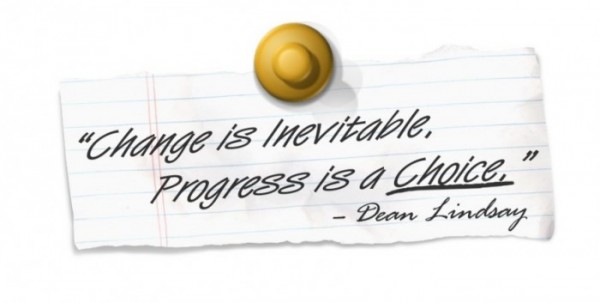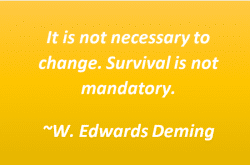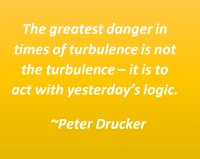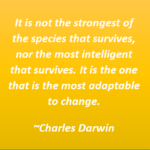Countless experts have commented on change. Dean Lindsay’s quote above frames today’s blog.
Change is inevitable…
It is no longer a question of whether or not your organization will face change, there are only the questions of
- How quickly will change come?
- How significantly will change impact our organization?
- How will we position and prepare our organization for change?
The democratization of technology has eliminated barriers to market entry. For this and other reasons, organizations face more competition and more volatile markets than ever before. Product life cycles are becoming shorter. The successful business models of today quickly become non-competitive. Threats and opportunities are abundant and less easily predicted.
Change is inevitable. What should we do to ensure that our organization survives and thrives?
Organizational utility…
Before addressing change management, let’s take a quick look at time management. As with change management, there are countless books and articles written about time management. But in truth, time management is a misnomer. We can’t manage time. It consistently and continuously marches on regardless of what we choose to do or not do. Time management is really about “activities management.” We choose what activities will fill our time. Can we make better choices about our activities? Of course! To borrow and paraphrase the “Economic Man” supposition proffered by economists, we will/should choose the activities that maximize our personal utility. Utility is defined uniquely for each individual, but generally includes concepts such as happiness, health, longevity, success, wealth, security, safety, respect, love, satisfaction, legacy…and the list goes on.
In like manner, change occurs regardless of what we choose to do or not do. But unlike time, we have the opportunity to manage change, or at least to manage how our organization responds to change. We can choose to do nothing. We can choose to embrace change. We can choose to be agents of change. There is no single best answer for all organizations in all situations. It is incumbent on us to make choices that maximize organizational utility. Organizational utility is all about maximizing shareholder or stakeholder value (see Shareholder vs Stakeholder Debate, MIT Sloan Management Review). We must continually ask, “are we getting value out of change; are we leveraging change to maximize organizational utility?” Management practices of yesterday may not work in today’s change environment.
Change management…
Given that change will happen, are we managing our activities in a way that will maximize organizational utility? The answer to that question forms the basis of “change management.”
What can we do to maximize change utility? The answer to that question can be elusive, but the following processes are essential.
Change strategy
We must craft our overarching change strategy. Organizations position themselves for change along a continuum:
How organizations position themselves for change is a strategic decision. Some embrace and even initiate change as an important strategic imperative. Others resist change because it threatens the status quo or weakens a heretofore successful business model. Most organizations either strategically or by default find themselves somewhere in the middle.
Organizational development
Through hiring, development, and training, organizations must have employees that embrace the chosen change strategy. In fact, other key stakeholders need to embrace the change strategy, including strategic partners, vendors, and the board. It is only when employees and other key stakeholders understand the change strategy and are willing and able to successfully implement change that organizational utility be maximized.
Change implementation
No matter how great the strategy or how prepared the organization, change will not result in progress unless it is well executed. Whether change is internally or externally focused, change management should be part of the implementation plan. This includes initiatives as large as launching a new product/service and as small as automating a manual process.
In closing…
“Change is inevitable. Progress is a choice” (Dean Lindsay). Organizations that survive and thrive will become expert at managing change. In the coming months, we will share blogs on the three processes suggested above:
- Change Strategy
- Organizational Development
- Change Implementation









